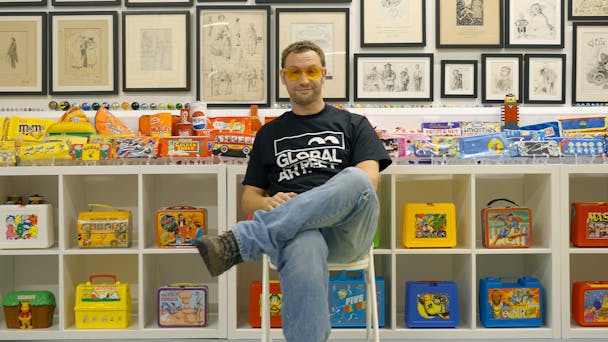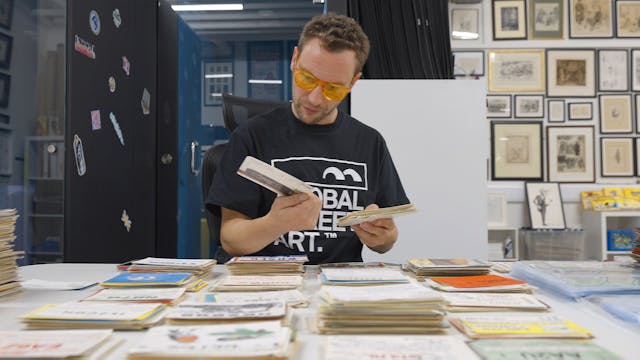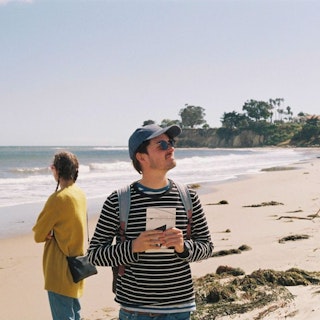How to be both: Global Street Art’s Lee Bofkin on marrying art and commerce
Lee Bofkin, founder of agency Global Street Art, has been named Leader of the Year at The Drum’s Out of Home Awards. We sat down with the Cambridge-PhD breakdancer to talk about a unique creative career.

The Drum Awards for Out of Home leader of the year, Lee Bofkin / Credit: Global Street Art
Global Street Art is best known in the marketing industry as the creator of big-ticket hand-painted murals, like giant QR codes for Which?, mural-projection hybrids for Fendi x Hennessy, a ‘wonky’ Specsavers execution, Gymshark’s recent ‘world’s first modest billboard’ and even The Drum’s own London HQ. It’s also a media owner (of sites like the enormous wall at Shoreditch’s 112 Tabernacle Street) and promoter of community art projects.
There’s a similar variety in the biography of the shop’s co-founder and chief executive, Lee Bofkin. After an undergraduate degree in biology at Oxford and a Cambridge PhD spent building mathematical models of the evolution of DNA, Bofkin’s career started at investment fund the Capital Group, where he met financier Koenraad Foulon, with whom he would found Global Street Art in 2012.
Advertisement
The jump from investment banking to mural art might sound like a surprising one until you hear a different story of Bofkin’s background: as a student, he taught himself to breakdance and ended up on the UK’s competitive breakdancing scene (as, perhaps unsurprisingly, their only Oxonian). A knee injury took him out of commission, but he was still traveling to breakdancing meets, which are hubs for other kinds of street culture, including graffiti, which he started to photograph and catalog.
“At the time, Flickr was the dominant photo-sharing site; before Instagram took over, everyone’s cameras got better and everyone became a professional photographer,” he says. From there, the business evolved into the street art equivalent of a media-agency-cum-media-owner, organizing space for street artists and walls for mural painters. “We knew landlords, we knew artists and I had a lot of execution experience… it was good training. Then, eventually, someone said, ‘Can you centrally do what you’ve been doing already?’ The penny dropped. ‘Oh, I get it, we’re an agency.’ But even before we were an agency, we had our mission: to live in painted cities. That’s not changed.”
The collector
Hand- and spray-painted work was already popular with clients and some small shops were able to help advertisers with some of the challenges of doing that kind of work (finding artists and sites, sourcing materials, securing permits, capturing secondary content), Bofkin says. The agency would offer it all at once.
It has been, Bofkin says, a profitable business ever since, painting murals and offices and (in the early days) taking gallery work. Now, the agency has a gallery of its own. Many agencies have small collections of memorabilia; what Global Street Art has is quite different: a vast library of knickknacks, tchotchkes, odds, ends and miscellanea from the last couple of centuries in advertising and product making. It’s like Robert Opie’s Museum of Brands mixed with an old-school agency’s ad library.
Advertisement
The collection includes thousands of these objects, including sub-collections of bubble bath bottles, pop-up books, cookie jars, ashtrays, joker cards and all sorts of advertising artifacts, from cheese cards to nightclub fliers. The centerpiece is Bofkin’s ‘Largely Forgotten Artists’ collection, comprising cartoons and other artworks from once-famous artists in popular media like legendary satirical magazine Punch.
Bofkin calls it “part gallery, part memory palace and part brain-training place.”

“I get a lot of pleasure from looking at art. It keeps the brain sharp. Human creativity has changed enormously with the advent of AI in the last 12 months or so, but I still don’t think we get nearly as much out of people as we’re capable of. One of the challenges of large language models is that they know everything; they’ve got such access to amazing information. But one of the things that’s cool about humans is they don’t. Everyone knows what they know and nothing else. That means you get different answers from different people. If someone’s collected different dots, they’ll connect dots in different ways. It’s the limitation – the unique collection of facts and histories – that makes us interesting.”
Creativity and commerce: a flashpoint?
Global Street Art, then, is an organization with feet in a few different worlds: an ad agency, executional partner and a media owner; a part of the street art world; a brand in its own right with hundreds of thousands of social followers; and an operator of community programs (including as organizers of the London Mural Festival).
Living authentically in each of those worlds isn’t easy. Here’s Bofkin when we start talking about financials and company ownership: “There’s a weird thing about this company: because it came from graffiti roots, there are some things that I just squirm thinking about or talking about – shareholders, turnover, the number of projects. I’m hampered by it… I just always try and tone down those conversations.”
Why? Because commerce and street art don’t always gel: “But I’ve made my peace with it. The nuance in the conversation is really important. Of course, we’re a commercial enterprise; if we don’t make money, we can’t survive. But the organization never existed with the purpose of making money; it does that as a byproduct of satisfying a client need.
“We didn’t set up to be specifically a hand-painted advertising business (though we want to do that better than anyone in the world). But it wouldn’t be the same company if we dropped our community programs – since 2012, we’ve organized over 3,000 legal, pure street-art murals… to reduce it to commercial terms doesn’t do justice to the effort we put into pursuing that mission”.
Suggested newsletters for you
Out-of-home and the ‘relentless drive for innovation’
Speaking of the agency’s mission, Bofkin hopes that the tangible artistry of hand-painted work can play some small role in what he calls “a rather dull ubiquity” that we’re coming to accept on digital channels. “The only thing that hasn’t changed is us,” he says. “So to give all of our stimulation over to a screen is unedifying and it gets boring. The natural counter is to do things in the real world that stop people in their tracks. Ironically enough, they’re then more likely to share it – a lot of the reach we get is online and I don’t decry that at all. Let’s be honest; no one photographs a banner ad.”
In this milieu, he says, stand-out real-world work stands to win big: “for most people today, innovation is digital and digital only… but our stuff competes digitally without being digital”.
This kind of work puts Bofkin’s agency, in the eyes of the industry, into a bucket labeled ‘special build,’ in the wider corner of outdoor advertising. But Bofkin wonders whether treating it as so special is the right path: “There’s a real logic in saying that our stuff should be standard media: sold on its dwell time, emotional response and [OOH measurement standard] Route Score. From an agency owner’s point of view, that might be a better business because the relentless drive for innovation is getting a bit exhausting and it invariably adds more complexity, often for not much more budget.”
‘If you build it, they will come’
Bofkin tells The Drum that a diagnosis of Asperger’s Syndrome in his 40s (one he hasn’t talked about publicly before for fear of being misread as using his neurodivergence to expand his platform) helped explain some of the skills that have served him well, like information recall. It also relates to some of the challenges he’s faced in leading an agency: “My interpersonal skills were really rough when I started this and I’m still working on them. But that’s just the quirky nature of how I’m constructed.”
It might also relate, he says, to his willingness to enter and try to merge different worlds – Oxbridge scholarship and breakdancing; street art and advertising.
“I absolutely love the area that we work in,” he says. “But do I feel like a natural CEO? That’s a no.” His job, he says, comes down to encouraging and preserving true human creativity. “I’m a scientist, but I also grew up Jewish. There are two parts of Judaism that really affect how I see the world today. The first is ‘pikuach nefesh,’ a principle in Jewish law that the preservation of human life overrides every other religious rule. The other is that they say you only die when the last person speaks your name. Those two points interact really strongly for me.”
Despite the apparent ephemerality of the mass-market objects and magazine cartoons in his collection, like the to-be-painted-over work of graffiti artists, Bofkin says, “I know their names and they deserve to be remembered… It’s about, essentially, celebrating craftsmanship and valuing humans a bit higher.”
Content created with:

Global Street Art
Global Street Art’s mission is “to Live in Painted Cities”. This is realised by working with top street artists, creating incredible murals for commercial...
Find out more
